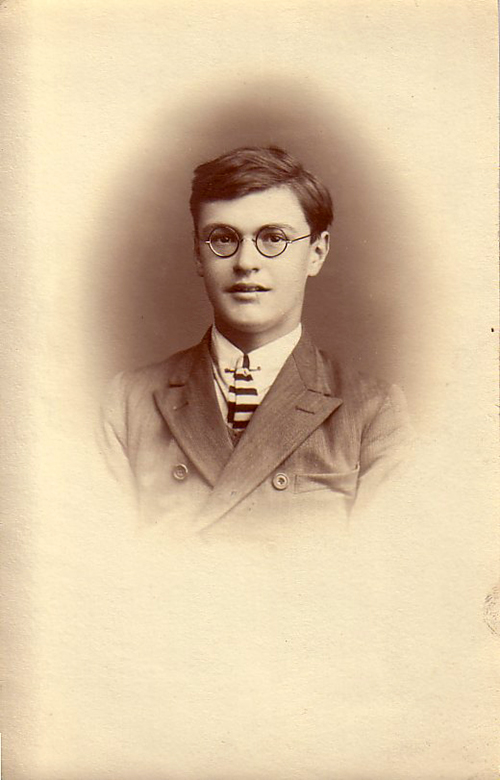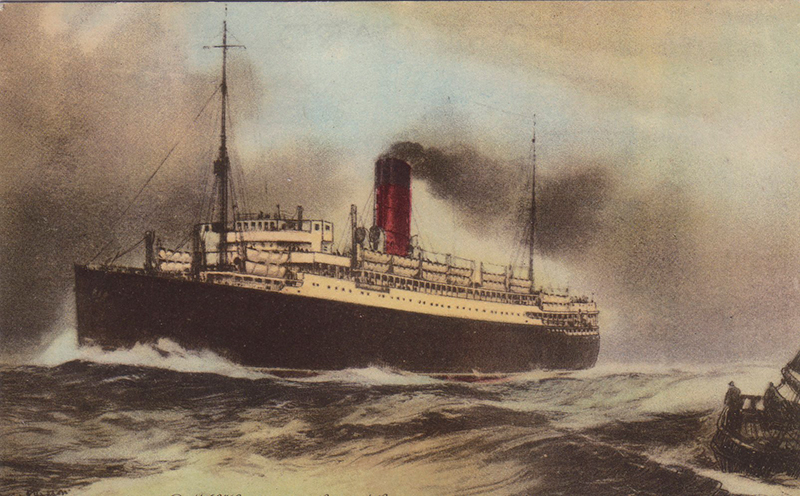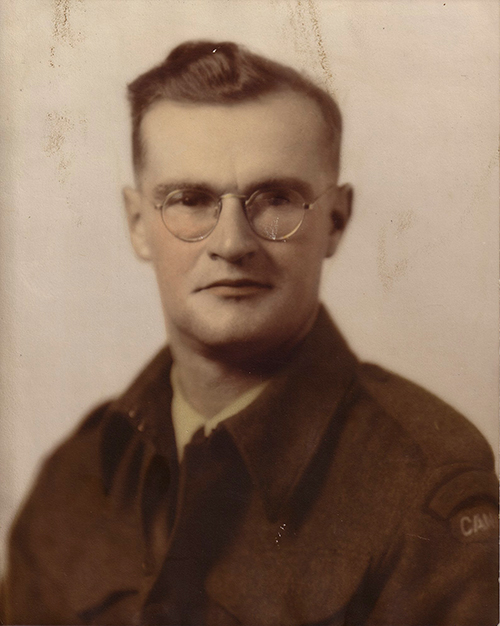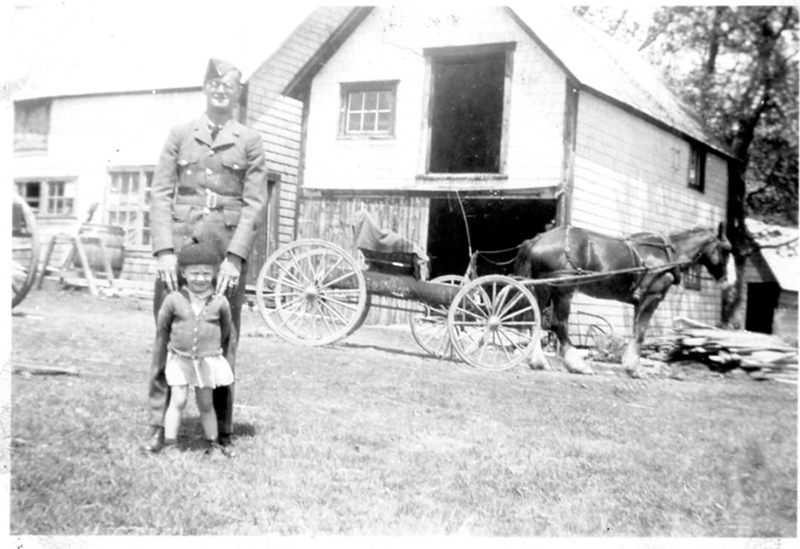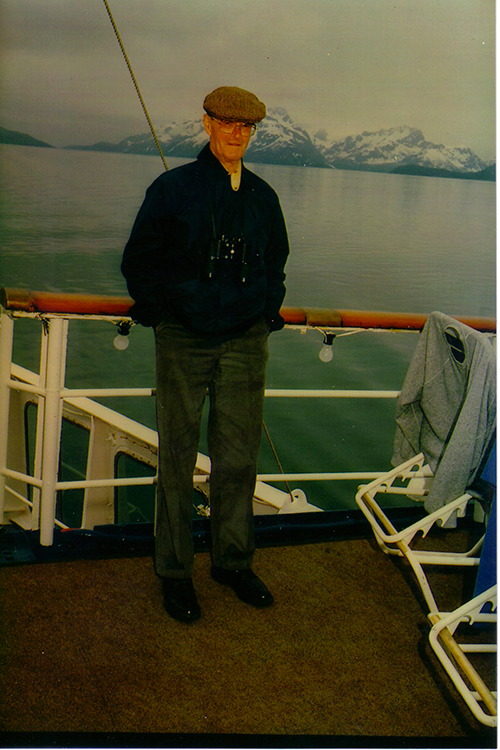Sobey Wall of Honour
Column
160
Row
21
The Early Years
Leonard Palmer was born on September 19, 1913 in England. He was adopted by Maud Florence and David Livingstone Palmer and was named after Leonard Hodgkinson, Senior 4th Engineer on the Titanic. He grew up in Hove, Sussex in southern England in a “Victorian” household. His mother was very stern and reserved and his father was much easier and accessible to the growing boy. At age 15, the Army would not take him as he was adopted, and he had no job prospects. In such cases, boys were sent off to the ‘colonies’ to earn a living. At that time, the Canadian government had a plan to bring British boys over to Canada to learn farming in hopes that they would stay and eventually buy a farm of their own. This was necessary as so many Canadians were killed in World War I that the future of Canadian farming was imperiled. He was accepted for the program, which would pay passage to Canada and $10 a month and board.
Off to Canada -
The Voyage From Liverpool to Baddeck
“My father took me to Liverpool on April 20, 1929 and sent a very anxious 15-½ year old aboard the R.M.S. Lancastria. We sailed down the Mersey River, stopped at Queenstown (Cobh), Ireland the next day and arrived in Halifax on April 27, 1929.”[1] Leonard was processed through Pier 21.
“The 12 of us aboard the Lancastria were taken to the Agriculture College in Truro, Nova Scotia for several days while our employment was sorted out.” On May 2, 1929, they were put on a train heading north and, one by one, they got off at their designated station. Leonard’s station was last, at Iona. He walked to the dock where he took a boat to Baddeck, his final destination. At the dock in Baddeck, the wharf agent met him and told him that his boss could not get into town that late but had made arrangements for the agent to take Leonard to a hotel for dinner and a place to stay for the night. The next day, his boss came along with a horse and wagon and took Leonard out to his farm.
Farming
This was Mr. James H. MacIver, a Scotsman who had lost his only son in World War I and now had no one to help with the farm. It was here that Leonard learned farming from scratch. Rosalie A. MacIver was the farmer’s wife. “She was a real Christian lady and she was like a mother to me. We hit it off from the start. … I enjoyed her company no end, she was like the mother I never really had.”
After Mr. MacIver passed away in 1930, his cousin took Leonard on to work at his farm nearby. After two years of hard work on this farm, Leonard asked the Agriculture people in Halifax for a job change, hopefully with more money. They got him a job in the Annapolis Valley with Mr. Peerman, an elderly gentleman from Worcester, England who had 50 acres of apple, pear, and cherry orchards.
In 1935, after five years with Mr. Peerman, Leonard had saved some money and decided to buy a small farm on Hunter’s Mountain in Cape Breton. On August 16, 1939 he married Hilda Loretta Ashe and a year later on August 12, 1940 a daughter was born. She was named Florence Catherine Rosalie Palmer. Florence for Leonard’s mother’s middle name, Catherine for a woman who took in Hilda, and Rosalie for Mrs. MacIver.
Military Service
When World War II was going on, Leonard tried to enlist in the Canadian Army but was turned down because he wore glasses. At a later time, he returned to Annapolis Valley to help Mr. Peerman harvest his apples. On the way back to Cape Breton, he had a layover in Halifax and visited a recruiting office. They accepted him into the Army with the restriction that he be placed into a noncombatant unit. Since his mother had been a nurse, he enlisted in the Royal Canadian Army Medical Corps in April 1943 at the age of 29.
The 3rd time must be a charm as he was turned down for the British Army in 1928 and turned down by the Canadian Army when World War II broke out, before being accepted by the Canadian Army in 1943.
Finding His Calling
After 3 months of basic training, he was assigned to the Cogswell Street Military Hospital in Halifax. (Historical note: It was built with large blocks of granite in the time when Queen Victoria’s father, the Duke of Kent, was O.I.C. of the force in Halifax.) He started out as an orderly and after a couple of months, he was asked to train for the Operating Room (O.R.). He greatly enjoyed this work and realized later in life how well he had been trained.
After a year at the hospital, the Lady Nelson, Canada’s only hospital ship at the time needed an O.R. Technician. Leonard applied and was accepted. This was to be only for one trip and he was then to return to the hospital. On his trip to England, he was able to visit his parents whom he had not seen in 10 years. The ship’s staff made sure that he had a kit bag full of food for his folks in England who were under rationing at the time. This one voyage turned into continuing assignments on the Lady Nelson.
After working in the ward on the Lady Nelson for several trips, they realized that he had been trained for the O.R. and transferred him to O.R. duty. The two staff members there (a nursing sister and an orderly) were not very accommodating. The next day, when the doctor arrived at the O.R. to perform surgery on a patient, nothing had been done to prepare the area or the patient. The doctor dressed down the two staff members and left the room. Leonard was ignored, but he had been trained in what to do and he got everything into shape for the doctor. Following the surgery, he cleaned up and sterilized the O.R. Next day, the nursing sister and orderly were transferred out of the O.R., Leonard was put in charge and promoted to Corporal, and given an assistant.
This time in the Canadian Army Medical Corps was a turning point in Leonard’s life. It lit a spark which would be turned into a career years later.
After the War
Leonard was discharged in 1946, sold the farm, and took a job in the O.R. of a Veterans Hospital for Tuberculosis patients in Deep Brook, Annapolis County, Nova Scotia. His wife’s roots were in Cape Breton and they moved back there in 1947 and bought a farm on Boularderie Island. It was on a main road and convenient to the little school house. This was a one-room schoolhouse for 8-10 pupils in grades 1-6. Leonard was the school secretary, interviewed teacher applicants, kept the financial books, and in winter, started up the pot-belly stove each morning so the school would be warm when the teacher and students arrived.
Boston and the Massachusetts General Hospital
One year, Leonard’s wife spent the winter in Boston with a friend and got a job there. She thought Boston had advantages for them and for schooling for their daughter. Leonard sold the farm in 1954 and he and his daughter Florence emigrated to the United States. They worked for the President of Boston’s largest bank for several years. During the winter of 1957, Leonard worked part-time at his “old love”, the O.R. at the Massachusetts General Hospital (Mass General). This turned into a full time job.
After a year and a half working in the O.R., the head of the Anesthesia Department convinced Leonard to transfer to his department. It was a new position and Leonard both learned it and defined it as he went along. The results of his work were so successful that soon, the other Doctors wanted him to take care of them as well.
The work involved keeping all the anesthesia machines clean, sterilized, and working well, keeping the induction rooms and anesthesia tables in the O.R. stocked, and ordering all supplies that the doctors would need. He found many of the existing procedures to be inefficient and “set out to put it right”. Eventually all three buildings at the hospital were following the same efficient procedures that Leonard devised. He devised an anesthesiology cart which efficiently carried all that was needed for the O.R.‘s. When a new building with 12 O.R.’s was built, Leonard’s duties expanded to include these as well. When the Shriners built a Children’s Burn Institute, he bought all the equipment for the O.R.’s in that building. One of the surgeons who appreciated Leonard’s work was Dr. White who was one of the early surgeons doing heart transplants.
Retirement
Leonard retired from Mass General in 1975 and spent his retirement traveling, taking cruises back to England and to different parts of the world, visiting his daughter and three grandsons, and spending time with friends in Boston. He passed in 1995. His cremains were taken back to England on his favorite ship, Cunard’s Queen Elizabeth 2, and were buried in the churchyard of St. Helen’s Church in Hove, Sussex, England.
Click here to read Leonard Palmer's Virtual Wall of Service Story
